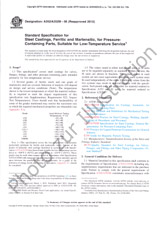Wir benötigen Ihre Einwilligung zur Verwendung der einzelnen Daten, damit Sie unter anderem Informationen zu Ihren Interessen einsehen können. Klicken Sie auf "OK", um Ihre Zustimmung zu erteilen.
ASTM E598-08(2020)
Standard Test Method for Measuring Extreme Heat-Transfer Rates from High-Energy Environments Using a Transient, Null-Point Calorimeter
Name übersetzen
NORM herausgegeben am 1.11.2020
Informationen über die Norm:
Bezeichnung normen: ASTM E598-08(2020)
Ausgabedatum normen: 1.11.2020
SKU: NS-1013266
Zahl der Seiten: 10
Gewicht ca.: 30 g (0.07 Pfund)
Land: Amerikanische technische Norm
Kategorie: Technische Normen ASTM
Kategorie - ähnliche Normen:
Die Annotation des Normtextes ASTM E598-08(2020) :
Keywords:
calorimeter, convective, heat flux, heat flux gage, null-point, radiative, transient temperature,, ICS Number Code 17.200.10 (Heat. Calorimetry)
Ergänzende Informationen
| Significance and Use | ||||
|
5.1?The purpose of this test method is to measure extremely high heat-transfer rates to a body immersed in either a static environment or in a high velocity fluid stream. This is usually accomplished while preserving the structural integrity of the measurement device for multiple exposures during the measurement period. Heat-transfer rates ranging up to 2.84 ? 102 MW/m2 (2.5 ? 104 Btu/ft2-sec) 5.2?Sources of error involving the null-point calorimeter in high heat-flux measurement applications are extensively discussed in Refs 5.3?Interpretation of results from null-point calorimeters will, in general, be the same as for other heat-flux sensors operating on the semi-infinite solid principle such as coaxial surface thermocouples and platinum thin-film gages. That is, the effects of surface chemical reactions, gradients in the local flow and energy fields, thermal radiation, and model alignment relative to the flow field vector will produce the same qualitative results as would be experienced with other types of heat flux sensors. In addition, signal conditioning and data processing can significantly influence the interpretation of null-point calorimeter data. |
||||
| 1. Scope | ||||
|
1.1?This test method covers the measurement of the heat-transfer rate or the heat flux to the surface of a solid body (test sample) using the measured transient temperature rise of a thermocouple located at the null point of a calorimeter that is installed in the body and is configured to simulate a semi-infinite solid. By definition the null point is a unique position on the axial centerline of a disturbed body which experiences the same transient temperature history as that on the surface of a solid body in the absence of the physical disturbance (hole) for the same heat-flux input. 1.2?Null-point calorimeters have been used to measure high convective or radiant heat-transfer rates to bodies immersed in both flowing and static environments of air, nitrogen, carbon dioxide, helium, hydrogen, and mixtures of these and other gases. Flow velocities have ranged from zero (static) through subsonic to hypersonic, total flow enthalpies from 1.16 to greater than 4.65 ? 101 MJ/kg (5 ? 10 2 to greater than 2 ? 104 Btu/lb.), and body pressures from 105 to greater than 1.5 ? 107 Pa (atmospheric to greater than 1.5 ? 102 atm). Measured heat-transfer rates have ranged from 5.68 to 2.84 ? 102 MW/m2 (5 ? 102 to 2.5 ? 104 Btu/ft2-sec). 1.3?The most common use of null-point calorimeters is to measure heat-transfer rates at the stagnation point of a solid body that is immersed in a high pressure, high enthalpy flowing gas stream, with the body axis usually oriented parallel to the flow axis (zero angle-of-attack). Use of null-point calorimeters at off-stagnation point locations and for angle-of-attack testing may pose special problems of calorimeter design and data interpretation. 1.4?This standard does not purport to address all of the safety concerns, if any, associated with its use. It is the responsibility of the user of this standard to establish appropriate safety, health, and environmental practices and determine the applicability of regulatory limitations prior to use. 1.5?This international standard was developed in accordance with internationally recognized principles on standardization established in the Decision on Principles for the Development of International Standards, Guides and Recommendations issued by the World Trade Organization Technical Barriers to Trade (TBT) Committee. |
||||
| 2. Referenced Documents | ||||
|
Empfehlungen:
Aktualisierung der technischen Normen
Wollen Sie sich sicher sein, dass Sie nur die gültigen technischen Normen verwenden?
Wir bieten Ihnen eine Lösung, die Ihnen eine Monatsübersicht über die Aktualität der von Ihnen angewandten Normen sicher stellt.
Brauchen Sie mehr Informationen? Sehen Sie sich diese Seite an.




 Cookies
Cookies
